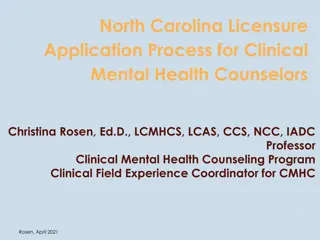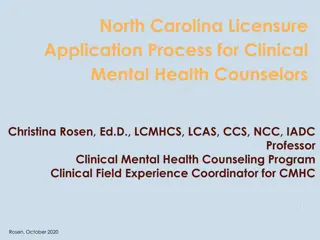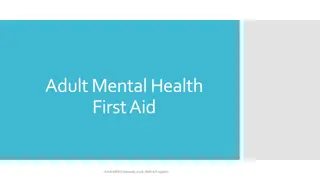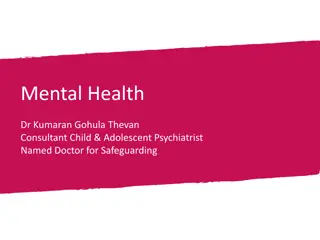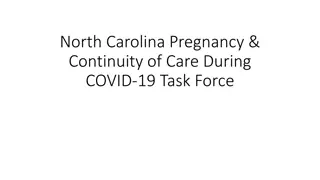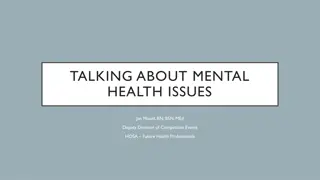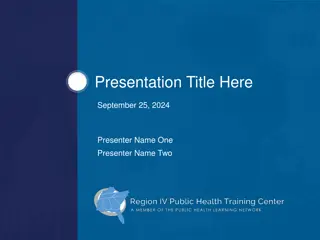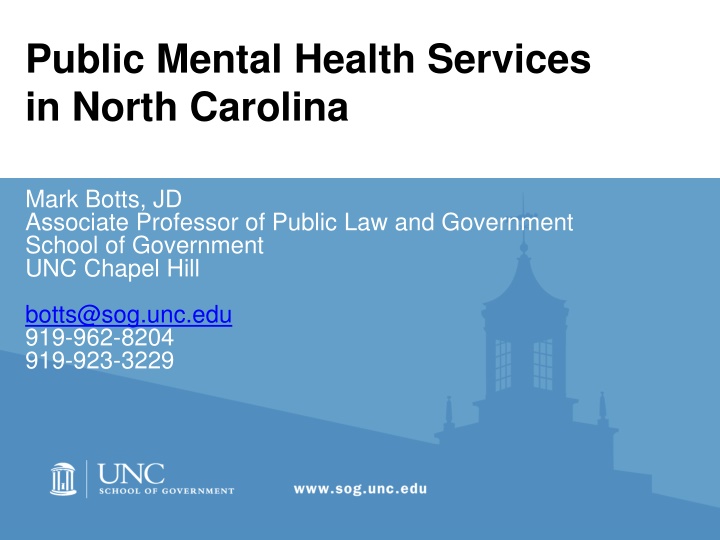
Area Authorities in North Carolina's Public Mental Health Services
Learn about the role and establishment of Area Authorities within North Carolina's public mental health services system, including governance structure and responsibilities. Discover how these local political subdivisions coordinate services for clients in their catchment areas.
Download Presentation

Please find below an Image/Link to download the presentation.
The content on the website is provided AS IS for your information and personal use only. It may not be sold, licensed, or shared on other websites without obtaining consent from the author. If you encounter any issues during the download, it is possible that the publisher has removed the file from their server.
You are allowed to download the files provided on this website for personal or commercial use, subject to the condition that they are used lawfully. All files are the property of their respective owners.
The content on the website is provided AS IS for your information and personal use only. It may not be sold, licensed, or shared on other websites without obtaining consent from the author.
E N D
Presentation Transcript
Public Mental Health Services in North Carolina Mark Botts, JD Associate Professor of Public Law and Government School of Government UNC Chapel Hill botts@sog.unc.edu 919-962-8204 919-923-3229
Community-based service system Area Authority Local Management Entity (LME) Managed Care Organization (MCO)
State Government Role DHHS Services 14 state-operated facilities (2,800) Funds for community-based services DMA Medicaid money (insured) DMH/DD/SAS Non-Medicaid funds (uninsured) Oversight of community-based system General Assembly policymaker Organization and Structure Funding Eligibility 3
WHAT IS AN AREA AUTHORITY AND WHAT DOES IT DO? 4
What is an area authority? An area authority is a local political subdivision of the state Within the public system of MH/DD/SA services an area authority is the locus of coordination among public services for clients of its catchment area G.S. 122C-101, -116. 5
How are they established? A county must establish an area authority A county must provide MH/DD/SA services through an area authority With DHHS Secretary approval: A county may disengage from one LME and realign with another Two area authorities may consolidate (merge) to create one larger area authority G.S. 122C-115. 6
Who Governs the LME? Boards of county commissioners within the LME s catchment area shall appoint governing board members according to a plan jointly adopted by the counties and that describes the board composition, appointment, and selection process LME board statute requires At least 11 and no more than 21 voting members 11 prescribed categories of professional and constituent representation G.S. 122C-118.1, 122C-115.2 7
Governing Board Duties Determine the needs of area authority clients Annually assess the area authority s ability to meet those needs. Submit to DHHS and BOCCs Quarterly service delivery reports that assess the quality and availability of services Annual report that assesses progress in achieving service goals and plans 8
What does an area authority do? Responsible for the management and oversight of the public system of MH/DD/SA services at the community level. Must plan, develop, implement, and monitor services within a specified geographic area to ensure expected outcomes for consumers within available resources. G.S. 122C-115.4
Who Pays for Services? Other 2% State and Federal Block Grant 17% $369 million County 1% Medicaid 80% Smoky Mountain Center FY 2015-16 Budgeted Revenues By Source
Where Does the State and Federal Money Go? Risk Reserve 1% $360.5million Admin. 11% Services 88% Smoky Mountain Center FY 2015-16 Budgeted Medicaid/State/Federal Revenues
Agency Functions and Mission Personnel Budget and finance Consumer affairs Information management To efficiently provide necessary and effective services to eligible people within available resources Services Access Provider relations Service management Quality management Community collaboration 13
Who is eligible and who receives services? Medicaid enrollees 22.7% of North Carolinians 16% of enrollees receive services Uninsured 13.6% of North Carolinians 8% of the uninsured receive services Prevelance (in need of services) 1,075,000 47% of these (475,000) receive services 14
Service Management Approve specific services to individual consumers service authorization Evaluate the medical necessity, clinical appropriateness, and effectiveness of services according to state criteria utilization management Monitor individual care decisions at critical treatment junctures to assure effective care is received when needed care coordination
Service Management LME Eligible individual? Covered service? Based on clinical assessment? Medically necessary? Qualified provider? Evidence that treatment helps? Other needed services? Outcomes over time? LME Provider
Managing Care Managing the quality of care Managing the cost of care LME Doctor Patient
Quality Management Analyze data on access, service authorization, and claims payment for: 1. high cost/high need consumers 2. utilization of various services in the service array 3. gaps in the service array 4. consumer access, initiation, engagement and retention The foregoing list is only a sample of the many QM activities that LMEs must engage in. 18
Community Collaboration LME must establish and maintain effective collaborative working relationships with other public agencies, health care providers, and human services agencies Must build a community collaborative of crisis/emergency stakeholders that engage in and support crisis prevention and stabilization, and that engages individuals into services after a crisis event
Collaborative Context Social Services Juvenile Justice Courts LME-MCO Health Care Providers Schools Others 20
WHAT DOES THE FUTURE LOOK LIKE? 21
Medicaid ReformS.L. 2015-245 Private health plans enter into prepaid, capitated contracts with the state For the delivery of all Medicaid and NC Health Choice services physical health services, prescription drugs, long-term care and supports, and behavioral health services whole care To all Medicaid and NC Health Choice aid categories enrollees (except those dually eligible for Medicaid and Medicare) In a specified geographic region defined by the State catchment area
What happens to LME-MCOs? 4 years after contracts begin LME/MCOs stop managing Medicaid behavioral health services or Create tailored plans for a defined special needs population public or non-profit entities separately manage population that has high need for behavioral healthcare and Permit LME/MCOs to compete for MCO contracts to manage both physical and behavioral healthcare for the special needs population. 23
When LME/MCOs lose Medicaid contract? What happens to the State funding for the indigent and uninsured who are not eligible for Medicaid? What happens to the non- Medicaid functions of an LME/MCO? Local service planning with stakeholders Collaborative working relationships with other public agencies Community collaborative of crisis/emergency stakeholders Coordinate services to juveniles in the juvenile justice system Perform multidisciplinary evaluations County 1% Other 2% State and Federal Block Grant 17% $400 million Medicaid 80% Social Services Juvenile Justice Courts LME-MCO Health Care Providers Schools Others
Policy Issues Integrated Care Medicaid Expansion/Funding Uninsured Workforce Development Inpatient Expenditures 25
Questions? Mark Botts 919.962.8204 botts@sog.unc.edu





